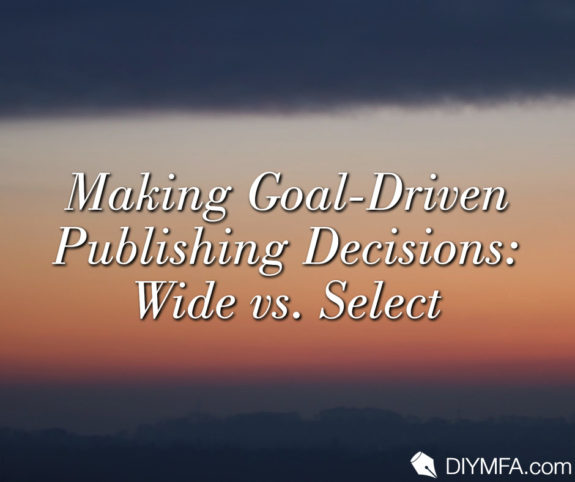After she’s written her manuscript, after it’s been edited, formatted, and proofread, an indie author makes a goal-driven publishing decision: wide or select? There are plenty of good reasons to choose either pathway, but it’s important to consider your long-term author goals before you decide.
What does “wide” mean here? What is “Select”?
“Select” means KDP Select, Amazon’s program that restricts electronic distribution of your ebook to Amazon in exchange for certain royalty and promotional perks. Choosing select means your ebook will be included in Kindle Unlimited (KU), so KU subscribers can read your book in the Kindle Owners’ Lending Library (KOLL) for free, but you get paid for the pages they read. “Wide” means foregoing those perks to publish your ebook on a variety of platforms and storefronts. Both Joanna Penn and the Alliance of Independent Authors offer valuable primers on the pros and cons of wide vs. select.
What’s your career objective?
The choice to publish wide vs. select represents a key strategic decision for the author-publisher. Reflect on your long-term business plan and your author goals, and consider which tactic will be more likely to get you where you wish to go. Although authors can switch back and forth between the two channels at will, the audiences are different. Cycling between the two may result in wasting time serving an audience that won’t support your goals in the long run, or failing to gain traction in your chosen sector.
Here are a few factors to consider:
- How many books do you have? Some authors, including prominent indies like Joanna Penn, recommend going with KU until you have at least two books, as it’s easier to learn a single platform first and then broaden your marketing.
- What genre or genres do you write in? KU readers favor romance, followed by fantasy and mystery. If you write outside these genres, you may find other platforms friendlier places to build readership.
- How diversified are your product offerings? Do you offer your books in ebook format only, or do you have print and audio options as well? If you offer products in multiple formats, you can choose to offer your ebooks in KU and offer your print and audio books in wider distribution.
- What’s your product release strategy? If your business model is to write constantly and publish frequently, Amazon exclusivity may benefit you, as you can learn to time releases and promotional days to make Amazon’s recommendation algorithms work in your favor. If you take longer to write your books, it may make sense to go wide, so you can take advantage of the different platforms’ opportunities to market your existing works while you bring the next one out.
- How comfortable are you with risk? Amazon offers a lot of benefits, but using a single retailer means assuming a great deal of business risk. Amazon can change their royalty structure or the KU business model at any time. Antitrust litigation could conceivably impact the way Amazon treats independent authors. The decision is akin to placing all your retirement funds in a single stock (even if it is Amazon stock), or a balanced portfolio of mutual funds. If you’re comfortable with that level of risk, the payoff from Amazon can be great. If you prefer to diversify your risk, wide makes sense.
Depending on the number of books you have and the formats you have them in, you can enjoy benefits of both markets. For example, you can offer a few ebooks in KU–a first book in a series, or a complete short series–and have your other ebooks (plus your print and audio versions) wide. Offering a few ebooks in KU lowers the risk to the reader, who doesn’t have to pay anything extra to try your book out. After reading your series, that reader may be willing to venture outside of KU to continue to support your career.
- What kind of audience do you want to build? Authors constantly work to build their platforms, or their readerships. With whom do you want to be in conversation? Although I love it anytime someone signs up to my mailing list, as a US-based author, I get a special thrill when I see an email address with a country extension on the top-level domain. If you desire to build a global audience, it’s hard to argue against choosing wide, because Amazon is not the dominant vendor in most countries. Even if you publish only in English, you can gain a global readership quickly.
This map shows my English-language international sales through Kobo, a Canada-based vendor with a major global presence. This kind of reach simply would not be possible by keeping my books in KDP Select. Aggregators such as Draft2Digital and PublishDrive maintain international networks of smaller vendors that can expand your reach and even help you with translations of your books.
- What’s your timeline? By publishing through KDP Select, even if you publish in a less-popular genre, you can achieve visibility quickly and easily (keeping it is another matter). Publishing wide demands patience. However, as vendors like Kobo and Apple and aggregators like Draft2Digital and PublishDrive offer more opportunities to market and promote your books, the gap will close.
There’s no right or wrong answer to the question whether to publish wide or select. The only thing that matters is what makes sense for your goals. With independent publishing, the tools are available for you to realize almost any goal you can envision, and you have the power to make all the decisions.

Helen J. Darling writes contemporary women’s fiction. Her latest novel, Terms and Conditions, was self-published in November 2019. You can connect with her at itshelendarling.com.







